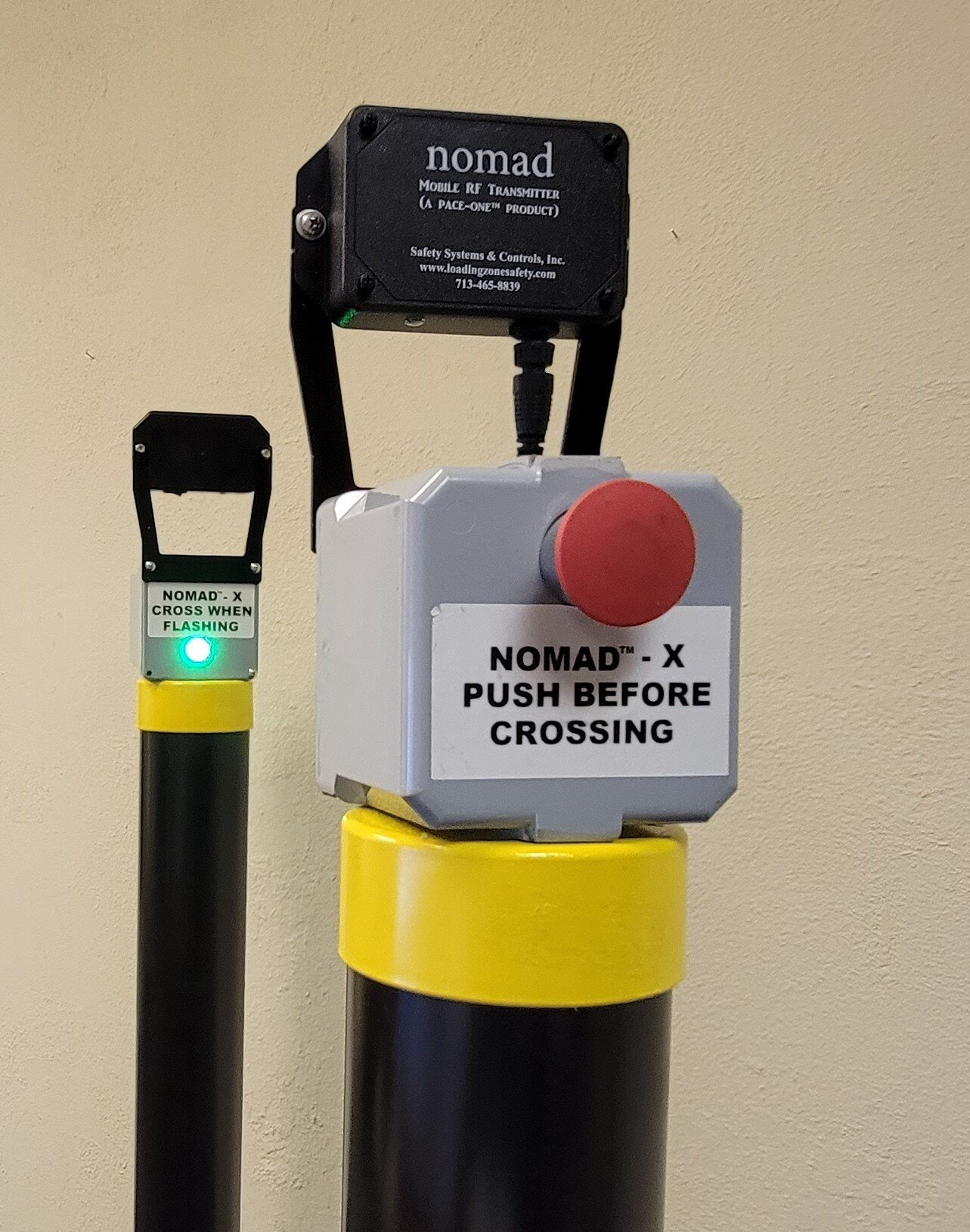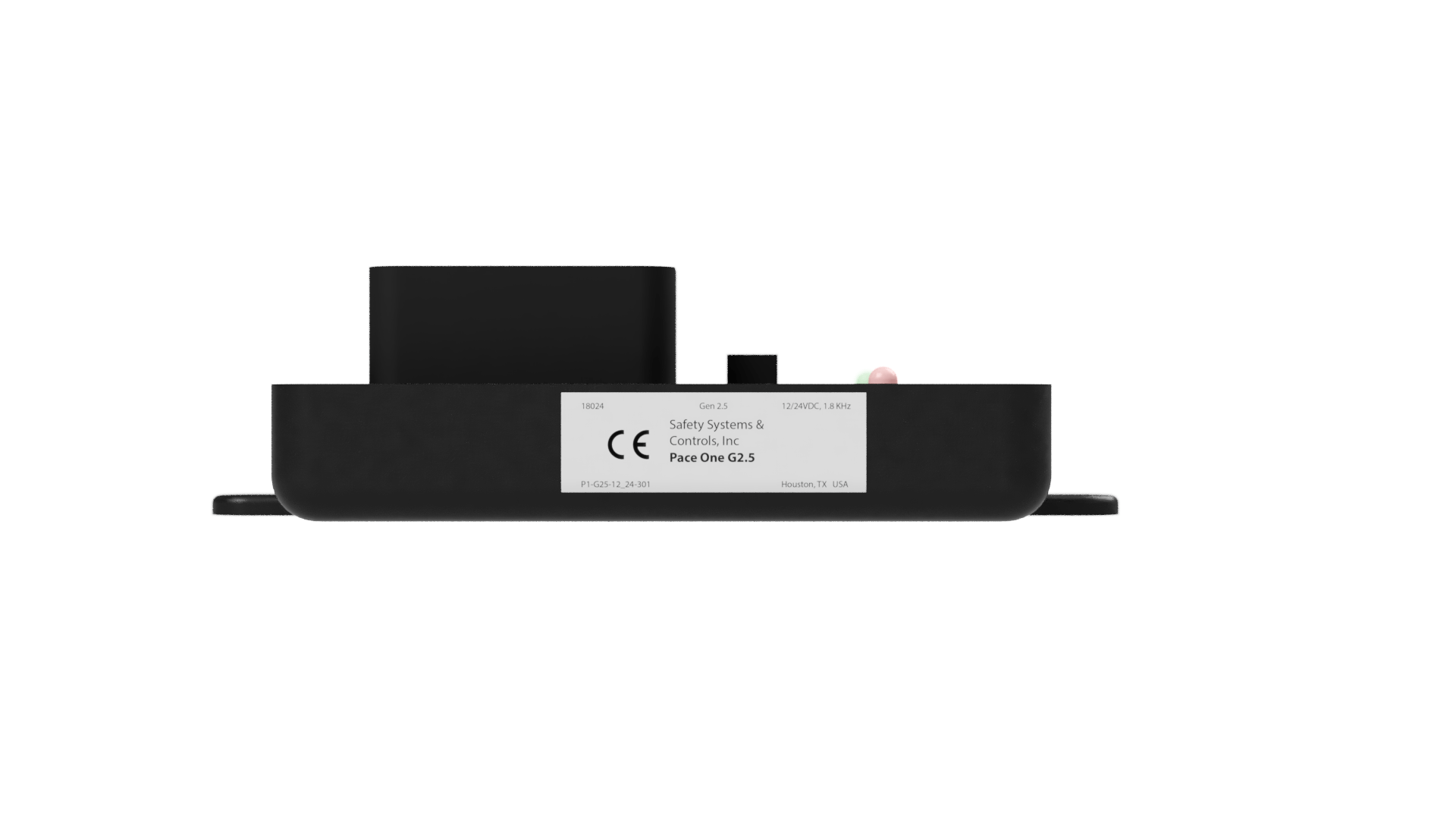RF TRANSMITTERS
Nomad ™
ON/OFF Speed Control
Nomad is a RF Transmitter and an optional component of SSC’s Pace-One Zone Speed Control (ZSC) system. When switched “ON”, it sends out an RF signal to the ZSC Receiver on the vehicle. When the vehicle is in range of the RF signal, it will limit top travel speed to the programmed level.
Multiple Applications
Nomad is designed for use by facility maintenance personnel as a temporary mobile safe zone. This is ideal when performing maintenance on manufacturing equipment, cleaning up spills, working on elevated platforms or used where excess inventory is staged or repackaged. Nomad can be placed on mobile equipment like rolling ladders or lifts, whenever in use all traffic in range slows around them.
No Wires
Zone and transmit power are set with dip switches on the circuit board. Nomad is powered by two CR2477 batteries giving it over a two year life.
Need a quote?
Give us a call at :
(713) 465 - 8839
Nomad / Ped-Guard Flyer
HOW IT WORKS
Programmable Zones
Transmitters can be placed through out the facility in order to achieve desired zones with set speed limits. By increasing the amount of transmitters in the facility, a more complex geometry can be achieved for a zone.
Be Aware - Stay Vigiliant
PEOPLE USING NOMAD AND/OR PED-GUARD SHOULD ALWAYS BE ONGUARD WHEN WORKING AROUND FORKLIFTS AND OTHER MOBIL EQUIPMENT AND NOT RELY SOLELY ON PED-GUARD TO HELP PROTECT THEM FROM EQUIPMENT IN MOTION. Likewise, equipment operators should ALWAYS observe proper operating procedures and slow vehicles when operating around pedestrians and in high traffic areas.

NOMAD X
Mounting / Components
Nomad X is mounted on each side of a pedestrian crossing. It can be mounted on a crossing gate, pedestrian barrier or standalone support. Each Nomad X consists of a mounting box containing a PC Board with internal timer, push-button, battery and pilot light (LED).”
Crosswalk Activation
Nomad X is activated by depressing a push-button on the mounting box. This powers Nomad X and generates an RF signal that slows Pace-One equipped vehicles AND wakens the Nomad X on the opposite side of the cross walk. In addition to slowing travel speeds, the LEDs on both boxes flash as visual indicators that Nomad X is activated. The activation time is programmable on the Nomad X circuit board. With this design, we have slower travel speeds or optional forced STOP (electric trucks) at crosswalks but only when there are pedestrians present. This continues SSC’s design directive of improving safety and doing so with minimal effects to productivity.
P1 Zone Speed Transmitter™
The P1 Zone Speed Transmitter™ is installed in fixed location to define a geographical speed zone. The location is typically chosen at a boundary between 2 speed zones. Each P1 Zone Speed Transmitter™ module has 2 individual transmitters. One of the transmitters broadcasts a speed zone in one direction. The other broadcasts another speed zone in the opposite direction. A Zone Speed Receiver™ that is exposed to these zone speed broadcasts is able to detect the zone boundary, and change the allowable maximum speed as it transitions from one speed zone to another.
Each of the 2 transmitters in the P1 Zone Speed Transmitter™ module is capable of transmitting 4 different zones. Only 1 zone can be transmitted by each transmitter at a time. The specific
zone that each transmitter in the P1 Zone Speed Transmitter™ module is transmitting is programmed with a single button during power-up. The single button is located next to a numeric display on the P1 Zone Speed Transmitter™ module. The numeric
display indicates the current zone selection. It also shows the selected zone during programming. The display only shows the zone information during power-up/start-up to conserve power. A
Green Status OK light Indicates that everything is working during normal operation. The green status light is blinking with a relatively low duty cycle to conserve power.

P1 Zone Speed Transmitter™
The P1 Zone Speed Transmitter™ is installed in fixed location to define a geographical speed zone. The location is typically chosen at a boundary between 2 speed zones. Each P1 Zone Speed Transmitter™ module has 2 individual transmitters. One of the transmitters broadcasts a speed zone in one direction. The other broadcasts another speed zone in the opposite direction. A Zone Speed Receiver™ that is exposed to these zone speed broadcasts is able to detect the zone boundary, and change the allowable maximum speed as it transitions from one speed zone to another.
Each of the 2 transmitters in the P1 Zone Speed Transmitter™ module is capable of transmitting 4 different zones. Only 1 zone can be transmitted by each transmitter at a time. The specific
zone that each transmitter in the P1 Zone Speed Transmitter™ module is transmitting is programmed with a single button during power-up. The single button is located next to a numeric display on the P1 Zone Speed Transmitter™ module. The numeric
display indicates the current zone selection. It also shows the selected zone during programming. The display only shows the zone information during power-up/start-up to conserve power. A
Green Status OK light Indicates that everything is working during normal operation. The green status light is blinking with a relatively low duty cycle to conserve power.
Ped-Guard™
New Paragraph
Like Nomad, Ped-Guard is an optional component of SSC’s Pace-One Zone Speed Control (ZSC) system. Ped-Guard slows vehicle travel speeds within the RF transmit area. Ped-Guard has no On/Off switch and powers automatically. Ped-Guard is ideally suited for use when giving Plant Tours or for anyone walking where mobile equipment is operating.
Easy to Wear
It can be worn like a watch, on a belt clip, on a lanyard or on a hard hat.
New Paragraph
In addition to slowing travel speeds, Ped-Guard vibrates (like a pager), alerting the individual wearing it that there is vehicle traffic nearby.
Battery
Ped-Guard is powered by a Lithium Polymer Battery. The battery is charged inductively (wireless charging) by a standard charging pad that conforms to the Qi standard. A fully charged battery typically lasts up to 2 weeks before needing recharging.
P1 Zone Speed Receiver™
The P1 Zone Speed Control Receiver™ detects signals (from the P1 Zone Speed Transmitter™) that define geographical zones in a vehicle environment. The signals define up to 4 different zones. The zone information is also transmitted to a Pace1™ speed controller.
An input signal is also provided to trigger an external event, such a pedestrian proximity. An optical, RF etc. receiver module may be connected to this external trigger signal to facilitate proximity sensing. The external trigger signal overrides any other zone detection, and automatically applies zone 3. Normal zone detection resumes automatically when the external trigger signal is no longer asserted.
The P1 Zone Speed Receiver™ also features a zone memory. The most recently detected zone is stored in memory when the ignition key is turned off. The stored zone is retrieved from memory when the P1 Zone Speed Receiver™ is powered up again (by turning the ignition key on). The P1 Zone Speed Receiver™ utilizes a modulated infrared signal to carry the zone information from the stationary Zone
Speed Transmitter™. The signal is also encoded to further reduce possible interference. The infrared signal medium necessitates line-of-sight communication between the P1 Zone Speed Transmitter™ and the P1 Zone Speed Receiver™.
P1 Zone Speed Receiver™
The P1 Zone Speed Control Receiver™ detects signals (from the P1 Zone Speed Transmitter™) that define geographical zones in a vehicle environment. The signals define up to 4 different zones. The zone information is also transmitted to a Pace1™ speed controller.
An input signal is also provided to trigger an external event, such a pedestrian proximity. An optical, RF etc. receiver module may be connected to this external trigger signal to facilitate proximity sensing. The external trigger signal overrides any other zone detection, and automatically applies zone 3. Normal zone detection resumes automatically when the external trigger signal is no longer asserted.
The P1 Zone Speed Receiver™ also features a zone memory. The most recently detected zone is stored in memory when the ignition key is turned off. The stored zone is retrieved from memory when the P1 Zone Speed Receiver™ is powered up again (by turning the ignition key on). The P1 Zone Speed Receiver™ utilizes a modulated infrared signal to carry the zone information from the stationary Zone
Speed Transmitter™. The signal is also encoded to further reduce possible interference. The infrared signal medium necessitates line-of-sight communication between the P1 Zone Speed Transmitter™ and the P1 Zone Speed Receiver™.
PACE-ONE™ G2
The PACE-ONE™ G2 ties the system together by receiving the acquired signals from the P1 Zone Speed Receiver™ and outputting the correct signals to the vehicle ECU in order to reduce throttle when needed. The PACE-ONE™ G2 can also be a stand-alone system in cases where zone speed limiting is not required.
Click here to learn more about our PACE-ONE™ G2 speed limiter.

PACE-ONE™ G2
The PACE-ONE™ G2 ties the system together by receiving the acquired signals from the P1 Zone Speed Receiver™ and outputting the correct signals to the vehicle ECU in order to reduce throttle when needed. The PACE-ONE™ G2 can also be a stand-alone system in cases where zone speed limiting is not required.
Click here to learn more about our PACE-ONE™ G2 speed limiter.

Do you have the programmer?
Click the button to get more information on our μCal™ programmer. With this device you can program any of our programmable products.
More Information
Do you have the programmer?
Click the button to get more information on our μCal™ programmer. With this device you can program any of our programmable products.
More Information
